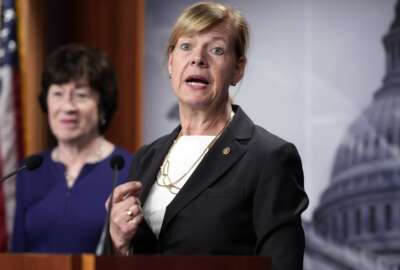Hubbard Radio Washington DC, LLC. All rights reserved. This website is not intended for users located within the European Economic Area.
Administration recognizes quality of work depends on quality of workforce
The goal was to achieve an efficient, effective and accountable government. A key strategy was to change the way the federal employee approached the job. In par...
By Lisa Wolfe
Program Director
Federal News Radio
In part 3 of Federal News Radio’s special report, The Obama Impact: Evaluating the Last Four Years, we focus on seven of the administration’s most important workforce initiatives. We rated four as effective (green), one as ineffective (red) and two as more progress needed (yellow). View the details of each initiative through our interactive dashboard.
|
WORKFORCE |
||||
|---|---|---|---|---|
| Security Clearances Hiring Reform Telework DoD Cyber Workforce |
Retirement SES Reform |
Support of Federal Employees | ||
More workforce links
Buyout Guide tracking agency early-outs
Pay and Benefits Tracker compilation of bills that could federal compensation
The hard work to accomplish President Barack Obama’s executive order intending to make the government more efficient, effective and accountable was given to the entire federal workforce.
They were asked to roll up their sleeves, lean in and get to it. Achievements in reducing backlogs in security clearances, attracting and keeping the best and brightest as civil servants and developing a trained cyber workforce are fruits of that labor.
In part 3 of Federal News Radio’s special report, The Obama Impact: Evaluating the Last Four Years, we focus on the direction the administration has given to the federal workforce.
Sometimes it’s not the words you choose, but the actions you take to support those words. In November 2010, President Obama called federal workers “patriots who love their country.”
Federal News Radio’s Ruben Gomez reports on how unions rate the administration on its support of federal employees (article)
Then Office of Management and Budget deputy director for management Jeff Zients said, “Federal employees are hardworking and dedicated and essential in delivering services essential to the American people.” Both comments came after the President announced a two-year pay freeze to all civilian employees.
The combination punch of a pay freeze and an increase in retirement contributions had a dramatic effect on the morale of the federal workforce. It took a nose dive.
The administration remained silent during the loud and ongoing debate on federal versus private-sector pay and during the numerous calls by Congress to leverage federal pay and benefits in the name of deficit reduction.
The impact from the administration’s decisions left federal employees feeling out in the cold and leaving us to rate the President’s support of federal employees ineffective.
David Snell, director of benefit services, National Active and Retired Federal Employees Association, on the retirement backlog (interview)
At one point, a retired civil servant waited, on average, five months before they received their first annuity payment. Today, the Office of Personnel Management estimates by September 2013, it will have eliminated the backlog entirely. It would be able to process most new claims in 60 days.
But the growing backlog of retirement claims and the extended wait faced by retirees for full benefits has long plagued the agency. In late 2011, OPM Director John Berry announced he would bring in an expert to help with the backlog and named former Federal Aviation Administration Chief Information Officer David Bowen as OPM’s new chief technology officer.
In January 2012, OPM sent lawmakers a detailed plan on tackling its retirement services backlog with more staff and upgraded technology. This approach came after three failed attempts over the last decade to develop and modernize the retirement system. Berry also ended the entire Retirement Systems Modernization program after determining it wasn’t going to work.
OPM made changes to chip away successfully at an ongoing inadequacy, but the progress came after years of complaints from retired federal employees and urgings from lawmakers.
Better news also comes with the recent law allowing phased federal retirement.
Senior Executive Service Reform
In February 2011, the President’s Management Council established a working group to identify, among other things, areas for improvement of the Senior Executive Service. OMB and OPM issued a joint memorandum to members of the SES, listing proposals to improve professional development programs; streamline cumbersome administrative processes; strengthen personnel performance management and grow executive talent pools.
Eduardo Ribas, chief human capital officer, Federal Energy Regulatory Commission, on SES reform (interview)
But by June 2011, movement on SES reform drew the ire of Carol Bonosaro, president of the Senior Executive Association, who said results were still unclear from the President’s Management Council’s “ambitious” agenda.
The administration, also in June, froze bonuses for SESers for two years.
Lawmakers earlier this year introduced companion bills in the House and Senate, both called the SES Reform Act of 2012, to make adjustments to the SES pay system, reduce the ratio of non-career-to-career senior executives, establish an SES Resource Office in OPM and require agencies to enhance professional development opportunities for senior executives. Both bills are still sit in committee.
Discussion on Senior Executive Service reform remains unfinished. A September Congressional Research Service Report details the current options for reform with regards to pay compression, recruiting and retaining SES members, career development and training, mobility of SES members, diversity and OPM’s management of the SES.
Never before has the government had such a well-strategized and well-documented plan to change many aspects of the federal hiring process. Chalk it up to effective administration leadership in OPM Director Berry. The administration embraced the spirit of hiring reform, made progress toward its stated goals and, as a result, demonstrated an influx of the new hires it set out to find.
Linda Bilmes, senior lecturer at Harvard’s Kennedy School of Government, discusses hiring reform (interview)
In the spring of 2010, the President issued a memo to improve the recruitment and hiring process. From that memo, three separate executive orders followed: Executive Order 13548 seeks to increase the number of individuals with disabilities in federal service; Executive Order 13518 addresses the employment of veterans in the federal government and Executive Order 13562 designs a recruiting and hiring strategy for students and recent graduates.
For the first time in decades, government created a set of programs to improve the recruiting and hiring of college students and recent graduates with the establishment of the Internship Program, Recent Graduates Program and Presidential Management Fellows Program. The final rule implementing the Pathways Program took effect in July.
According to performance.gov, OPM has shown continued improvement in hiring process in part by requiring job opportunity announcements be written in plain language and eliminating KSAs.
Agencies found it easier to hire veterans after FedsHireVets.com launched January 2010. The number of veterans employed by the federal government increased from 512,000 (25.8 percent) in fiscal 2009 to 567,000 (27.3 percent) in fiscal 2011. Also in 2011, 28.3 percent of all newly hired employees were veterans. This represented the highest percentage of veterans hired in a given year in more than two decades. The hiring of disabled veterans also rose from 7 percent in 2009 to 9 percent in 2011.
The success of FedsHireVets.gov website was so apparent, the founders were named finalists in the Service to American Medal award for their efforts.
Even though OPM has missed some key priority goals, the great strides in hiring reform make this an effective effort.
The longstanding delays and backlogs with personnel security clearances were effectively addressed by the Obama Administration. Sen. Daniel Akaka (D-Hawaii) said in a June 2012 hearing on the status of security clearance reform, “initial investigations take an average of 44 days to complete, compared to a staggering 189 days in 2005.”
Evan Lesser, President of ClearanceJobs.com, on improving the security-clearance process (interview)
This was the honey produced by thousands of busy bees.
In 2009, the Federal Investigative Services Division within the Office of Personnel Management issued a plan to make more efficient their role in streamlining the clearance process.
Those and many other efforts by OPM, the Office of Management and Budget and the Office of the Director of National Intelligence resulted in the Government Accountability Office removing the Defense Department’s security clearance program from the high risk list. GAO cited robust congressional oversight and the “committed leadership” of the Suitability and Security Clearance Performance Accountability Council, or PAC, as a key driver of the reforms.
Telework is good for the government soul. Its altruistic visage creates a warm connection between manager and employee with the agreement that employees deserve work-life balance. But embedded deep in the telework DNA are recruitment and retention benefits, cost-savings and a built-in continuity of operations or COOP strategy.
George Jakabcin, chief information officer, Treasury Inspector General for Tax Administration (interview)
Agency adoption rates of the teleworking culture have never been higher and there are numbers to prove it. According to OPM’s 2012 Status of Telework report to Congress, all 87 agencies participating in an OPM Data Call had established telework policies and 73 percent of the policies met the Telework Act requirements. More than 144,000 federal employees had written teleworking agreements with their agency. And 27 percent of teleworkers worked remotely three or more days per week.
These numbers didn’t just materialize. In late 2010, the President signed the Telework Enhancement Act, giving agencies a map of the race route and an energy bar to run the marathon. Along the way, OPM provided advice on how best to comply with the requirements of the law while the General Services Administration made important resources available.
By June 2012, the mechanisms to support federal telework policy had become indoctrinated, systemized and automated. Prior to this development, any data was provided voluntarily by agencies. OPM’s 2012 report to Congress now becomes a baseline for measuring the effects of telework in the future to see that it remains efficient, effective and accountable.
In 2009, then-Defense Secretary Robert Gates identified the need for a new national strategy for cybersecurity. At the same time, he directed the establishment of “a subordinate unified command designated as U.S. Cyber Command.”
Federal News Radio DoD reporter Jared Serbu’s report on DoD’s efforts to build its cyber workforce (article)
And so the process of standing up USCYBERCOM began. Along the way, there were bumps in the road to recruiting and hiring a cyber workforce. In September 2010, Gen. Keith Alexander, commander of U.S. Cyber Command, told the House Armed Services committee staffing issues were one of the reasons USCYBERCOM would miss the initial “fully operational” deadline.
Because all four military branches staff USCYBERCOM, it’s important each service develop its own talent. But developing cyber expertise is a common challenge all of the military services are up against.
Less than a year after it first became operational, the Army’s cyber command was struggling to recruit and retain a workforce that could fight in and defend cyberspace. The Army responded to the challenge by creating a pilot program it called the Green Pages, a talent management system the service hopes would help find skills it already has among its personnel but just doesn’t know about. Soldiers and civilians can build a social networking-style profile that includes their own personal background, skills and education.
The Air Force also has a system to keep their best cyber warriors. It created a career path for both officers and enlisted personnel specifically intended to let cyber experts stay in the field throughout their military careers.
The Defense Department, as a whole, is doing a decent job of defining and refining its cyber talent needs. Earlier this year, DoD identified capabilities that would lead to cyber victory. In a letter to Congress, Alexander praised cyber teams modeled in CYBER FLAG exercises that combine both attack and defend capabilities under a single commander.
Most recently in June 2012, Alexander defined which national cyberspace missions belong to each of the four DoD branches helping to further clarify skills and abilities sought in the cyber workforce.
RELATED STORIES:
Number of federal teleworkers hits all-time high
Obama signs highway, student loan deal with phased retirement
Military branches refine cyber roles
More from the special report, The Obama Impact: Evaluating the Last Four Years
Obama administration a mix of successes and failures
Part 1: Evaluating the Obama administration’s management initiatives
Part 2: Technology reforms gives agencies a needed lift
Part 3: Administration recognizes quality of work depends on quality of workforce
Part 4: Evaluating Obama’s acquisition initiatives
Part 5: What would a second-term for President Obama mean for feds?
Copyright © 2024 Federal News Network. All rights reserved. This website is not intended for users located within the European Economic Area.
-
Don’t look now, but your TSP is swooning Federal Drive
-
DoD gets serious about technology transfer to the troops Federal Drive




